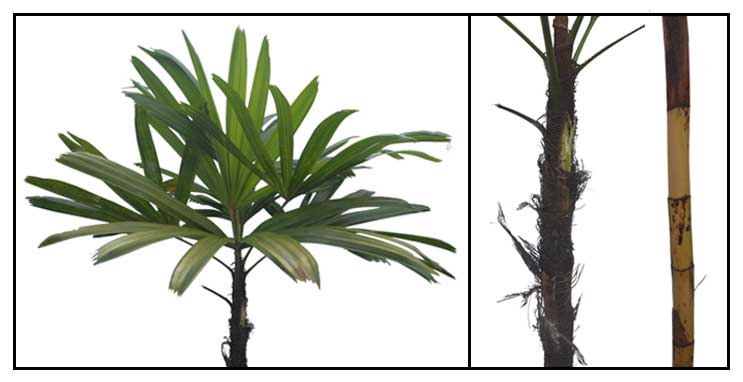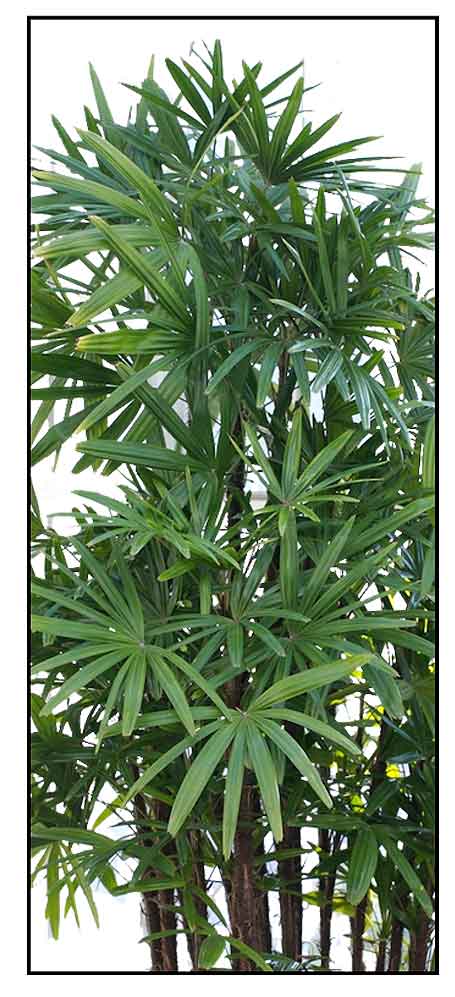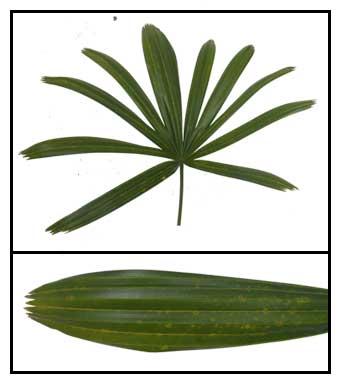 Gen info Gen info
- Rhapis excels is a species of fan palm in the genus Rhapis in the family Carapace.
- Etymology: The genus name Rhapis derives from Greek 'rhapis', meaning "needle," referring to the leaf segments. The species epithet derives from Latin, meaning "tall", although R. excels is not the tallest in the genus. (16)
- The UK has granted the plant the Royal Horticultural Society's Award of Garden Merit. (16)
 Botany Botany
• Rhapis excels is an erect, slender, suckering and clustering palm, erect and slender, growing up to 3 to 4 meters tall. Stem is cane-like, up to 4 centimeters in diameter, densely wrapped with dark-brown mats of coarse fiber. Leaves are palmate divided into broad, ribbed segments, appearing like a dissected fan. Leaf ends are saw-toothed in slender petioles up 20 to 50 centimeters long, smooth, stiff or arching. As the lower leaves fall off, stems are left with scars that give a bamboo-like appearance. New foliage emerges from fibrous sheath which remains attached to the base. Small inflorescences occur at the top, with spirally-arranged fleshy flowers with three petals fused at the base.
• Rhapis excels grows up to 4 m in height and 30 mm in diameter in multi-stemmed clumps with glossy, palmate evergreen leaves divided into broad, ribbed segments. Leaf segments are single or few in young plants and increase to a dozen or more in mature plants; segments are divided to the petiole. Leaf-ends are saw-toothed unlike most other palms, occurring on slender petioles ranging from 20 to 60 cm in length. New foliage emerges from a fibrous sheath which remains attached to the base. As the plants age, the sheaths fall, revealing the bamboo-like trunks. Usually dioecious, the palm species produces a small inflorescence at the top of the plant with spirally-arranged, fleshy yellow flowers containing three petals fused at the base. Ripe fruit are fleshy and white, though R. excels more readily propagates via underground rhizome offshoots. (16)
Distribution
- Introduced to the Philippines in the early 1900s.
- Ornamental cultivation.
- Used for dense hedges.
- Native to China Southeast, Hainan, Vietnam.
Constituents
- Methanol extract of leaves yielded terpenoids, steroids and triterpenoids, saponins, glycosides, cardiac glycosides, phytosterols, resins, phenols, flavonoids, and oxalic acid. (see study below) (3)
- Chromatographic fractionation of R. excels leaves isolated four flavonoids: Apigenin-8-C-glucoside (vitexin), Apigenin-6,8-Di-C-β- glucopyranoside (vicenin-2), Luteolin-6-C-glucoside (isoorientin) and Luteolin-8-C-glucoside (orientin). (see study below) (4)
 Properties Properties
- Considered hemostatic, antidysenteric, and circulatory tonic.
- Studies have shown anti-viral, bacteriostatic, cytotoxic, antioxidant, acetylcholinesteral inhibitory, antidermatophytic properties.
Parts used
Bark, roots.
Uses
Folkloric
- No known folkloric medicinal use in the Philippines.
-
Burned or charred bark applied externally to stop bleeding. (1)
- Decoction of roots or ashes from burnt bark used for rheumatism; also used to stimulate blood circulation.
(1)
- Used as hemostatic and antidysenteric.
(12)
Others
- Air-cleaning Indoor Plant: Used as air-filtering plant.
Studies
• Air-Filtering Property: Included in the NASA list of 10 Best Air Filtering House Plants, Raphis excels is considered capable indoor air purification—eliminating formaldehyde, ammonia, xylene and toluene from indoor environment. (1)
• Phytochemicals / Antioxidant / Leaves: Study evaluated leaves of Rhapis excels for phytochemical composition, antioxidant activity and FTIR evaluation. Total phenolics and terpenoids in the methanolic extract showed 11 mg GAE/g and 130 mg/g, respectively. Hydrogen peroxide and reducing power scavenging assays were used to evaluated antioxidant activity. Results showed moderate to significant antioxidant activity. (see constituents above) (3)
• Flavonoids / Antioxidant / Antibacterial Potentiation / Leaves: Study of leaves extract yielded four flavonoids. Ethyl acetate and butanol fractions showed remarkable antioxidant activity (86.2 and 75.6 respectively) on DPPH radical scavenging assay. The extracts had no antimicrobial activity alone, but revealed an ability to potentiate the antibacterial activity of ciprofloxacin, tetracycline and oxacillin. (see constituents above) (4)
• Anti-Chikungunya Virus Activity / Antifungal / Bacteriostatic: Study investigated the antimicrobial and antiviral potential of three medicinal plants viz., Catunaregam spinosa, Houttunyia cordata, and Rhapis excels All the extracts showed bacteriostatic activity. The ethanol extract of R. excels exhibited the strongest fungicidal activity against C. albicans, C. parapsilosis and T. mentagrophytes with minimum fungicidal concentration (MFC) of 0.04-0.08 mg/mL. Only the chloroform and ethyl acetate extract of R. excels showed significant antiviral activity against Chikungunya virus with 50% effective concentrations (EC50) of 29.9 and 78.1 g/mL. (6)
• Cytotoxicity / Anti-CHIKV Testing: Study investigated a total of 30 crude extracts from leaves and aerial parts of five Malaysian plants (Ipomoea aquatica, Persicaria odorata, Rhapis excels, Rhoeo spathacea, and Vernonia amygdalina) for anti-CHIKV activity. On cytotoxicity testing on Vero cells in a 72 hour NRU (neutral red uptake) assay, the ethanol extract of R. excels showed the highest cytotoxicity with CC50 of 51.67±2.89 µg/mL. In post-inoculation antiviral assay, all the extracts did not achieve the half-maximal effective concentration (EC50). (7)
• Anti-Chikungunya Virus Activity: Chikungunya virus is a reemerging arbovirus transmitted mainly by Aedes aegypti mosquito. Study investigated 120 extracts from 20 selected medicinal plants for anti-Chikungunya activity. Quantitative RT-PCR analysis showed the chloroform extract of Rhapis excels leaves exhibited the highest percentage of viral load reduction (98.1%) with EC50 of 29.9 ± 0.9 and selectivity index of 5.4. (10)
• Comparative Indoor VOC Absorption: Study evaluated the effectiveness of VOC (volatile organic compounds) absorption between Rhapis excels, Nephrolepis exaltata, and Dracaena fragrans in small rooms. Among the three plants, R. excels was identified as the best indoor plant to absorb VOC with the highest decrement when using six plants. (11)
• Antidermatophytic / Leaves: Study evaluated the antidermatophytic activity of 48 extracts obtained from medicinal plants and marine algae. Ethanol and methanolic leaf extracts of R. excels and methanol and water extracts of S. myrtifolium were highly active (MFC <0.1 mg/mL) with highly selective indices (SI>2.8) against reference strains T. rubrum and T. interdigitale, and most of the clinical isolates of T. tonsurans. Phytochemical analysis showed presence of alkaloids, anthraquinones, flavonoids, saponins, tannins, phenolics and triterpenoids in the extracts. (13)
• Anti-Chikungunya Virus Activity / Leaves: Methanolic extract of leaves yielded 4 flavonoids i.e., Apigenin-8-C-glucoside (vitexin), Apigenin-6, 8-Di-C-βglucopyranoside (vicenin-2), Luteolin-6-C-glucoside (iso-orientin), and Luteolin-8-C-glucoside (orientin). In a study of six leaves extracts by Chan et al., the chloroform extract (30 µg/ml) exhibited the strongest inhibition of the cytopathic effect of CHIKV without significant cytotoxicity. The strong anti-chikungunya activity was confirmed by quantitative RT-PCR analysis that showed the extract reduced viral load by 98% compared to virus control. Results suggest the extract might have direct virucidal effects on CHIKV. (17)
• Acetylcholinesterase Inhibitory Activity / Leaves: Study evaluated 31 selected medicinal plants from Perlis for potential AChE inhibitors. Dichloromethane and alcoholic extracts were screening for AChE inhibitory activity using Ellman's method. Out of 31 plant species, methanol extracts of Rhapis excelsa leaves (97.03%), Diospyros blancoi leaves (95.80%), and Phyllantus elegans roots (83.22%) showed highest AChE inhibitory activity at concentration of 100 µg/mL. (18)
Availability
- Wildcrafted.
- Ornamental cultivation.
- Plant and seeds in the cybermarket.
|

![]()



 Gen info
Gen info
 Properties
Properties